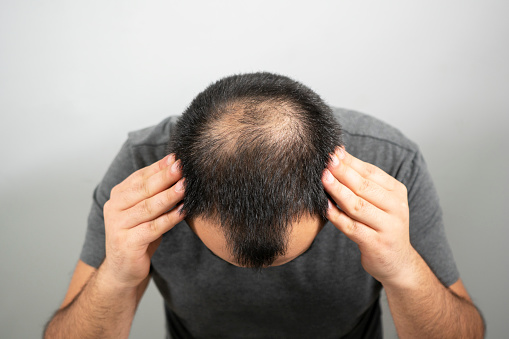
You might have heard people say that men with hair loss have higher testosterone levels, but that is not entirely accurate. Yes, testosterone does play a role in male-patterned or female-patterned baldness, albeit an insignificant one. Throughout history, scientists noticed that men with no testosterone levels due to the now-outdated practice of castration were more likely to maintain their hair. However, men with low testosterone may still go bald.
The impact of testosterone on hair loss is more complex than many people realize. With other hormones like dihydrotestosterone, combined with genetics, hair loss cannot be attributed to testosterone alone. Testosterone as the source of hair loss is a simple misunderstanding with a complex answer.
During a process called miniaturization, hair follicles shrink over time, resulting in the eventual inability of that follicle to grow hair. As hair follicles shrink, new hair becomes narrower until it is too fine to grow, and the hair follicle becomes inactive and unable to produce hair. A hormone synthesized by testosterone impacts the process of miniaturization and hair loss. In this way, testosterone indirectly affects hair loss.
Dihydrotestosterone, or DHT, is a hormone synthesized from testosterone in the prostate gland, skin, hair follicles, liver, brain, and genitalia. DHT is the hormone that impacts hair loss but, by itself, cannot cause or prevent it. The sensitivity of hair follicles to the actions of DHT is what results in hair loss.
Genetics determine how sensitive hair follicles are to DHT, which is no surprise, as male patterned baldness tends to be familial. Androgen receptors (AR) on hair follicles interact with testosterone and DHT. The AR gene makes these receptors and determines how sensitive they are to DHT. Because DHT shrinks hair follicles, the more sensitive the androgen receptors are to DHT, the more likely those hair follicles will experience hair loss.
Women sometimes experience hair loss in the same way as men, even with lower levels of testosterone and DHT. 50 million men and 30 million women in the United States experience androgenic alopecia, or hair loss related to hair follicle shrinkage. It is most likely to occur in women after menopause, and at least half of older will have some amount of hair loss.
Hair loss is not well understood, with many people believing that men with higher levels of testosterone are more likely to experience hair loss, or men with hair loss are more virile. Unfortunately, men cannot claim that their hair loss makes them more of a man, or that they have higher levels of male-specific hormones circulating in their system. The best they can do is blame their genetic makeup. A full head of hair or balding in your 20s is not an accurate way to predict testosterone levels.
The impact of testosterone on hair loss has a loose connection and plays only a minor role in the process. In both men and women, not all hair loss is androgenic alopecia. There are multiple reasons why someone might be losing their hair, from nutritional deficiencies to other hormonal causes. Contact us for more information on the causes of thinning hair.